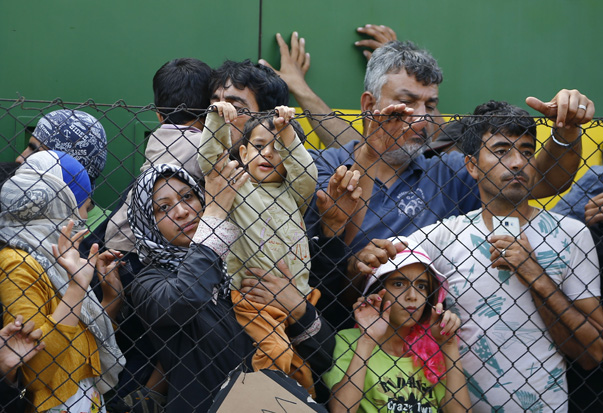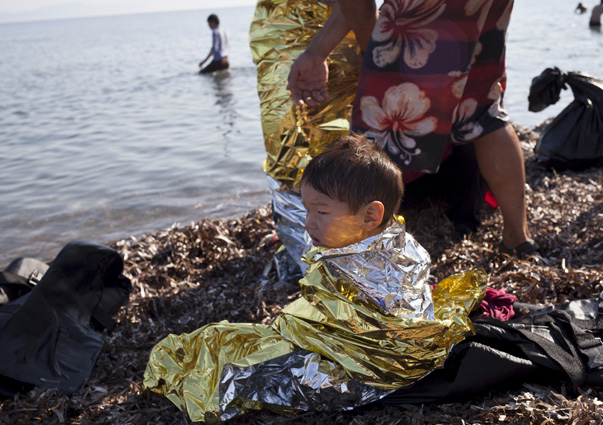
How many refugees and migrants are coming to Europe?
The number of people coming from outside Europe to claim asylum has risen significantly since 2011.
These are the annual figures for people asking for asylum in the 28 countries of the EU as well as Iceland, Norway, Switzerland and Liechtenstein until 2014, when there were 662,205 applications:
http://static.data.c4news.com/aQ29q/index.html
This is not technically the biggest influx of asylum seekers on record. In 1992 there were 697,085 applications, more than 438,000 in Germany alone, a surge driven mainly by refugees from the conflict in the Balkans.
But the very latest figures suggest the crisis has become even more acute in recent months.
There were 838,305 asylum applications across those 32 European countries in the 12 months to June 2015, a 62 per cent increase on the 516,250 applications made in the previous 12 months.
http://static.data.c4news.com/pJbjt/index.html
Both the EU border agency Frontex and the International Organisation for Migration (IOM) have both said the current crisis is the worst since the Second World War.
Frontex publishes figures for people detected illegally crossing the external borders of the EU. The figure of more than 280,000 detections in 2014 was a new record, double the previous high in 2011, the year of the Arab Spring:
http://static.data.c4news.com/HZTcK/index.html
These numbers are not in addition to the asylum stats – they include many people who will later have applied for asylum.
And they don’t include people who managed to enter Europe illegally without the authorities noticing.
Where are people coming from?
In 2014 the biggest group of asylum seekers came from Syria, followed by Afghanistan, Kosovo, Eritrea and Serbia.
There are other complex trends though. There have been recent rises in applications from several African countries, notably Nigeria, as well as Ukraine and Iraq.
Even if you strip out Syria (green) and the other top five countries, there is still a rise in asylum seekers from the rest of the world coming to European countries (red):
http://static.data.c4news.com/XlZns/index.html
How do they get here?
Frontex publishes details of the main routes people are using to get into Europe illegally.
By far the biggest are the “central Mediterranean route” (by boat from North Africa to Malta and southern Italy); the “eastern Mediterranean route” (by sea and land into Greece, Bulgaria and Cyprus) and the “western Balkan route” (from eastern Europe or Asia to Hungary via the Balkans).
The border agency points out that illegal migration isn’t just about people hiding in trucks and or braving the Mediterranean, saying: “One of the biggest entry routes for migrants into the EU is via international airports.
“Most of those who currently reside in the EU illegally, originally entered in possession of valid travel documents and a visa whose validity period they have since overstayed.”
Where do they go?
Here’s a map showing how many asylum claims were made across Europe last year. Click on the country to get the number.
Germany saw by far the biggest number of claims – more than 202,000 – and Britain had about 32,000, the sixth largest number.
http://static.data.c4news.com/ic0Qa/index.html
What about the people who don’t make it?
The IOM is trying to keep a count of how many people are dying trying to get into Europe.
As of yesterday, 2,701 have died trying to cross the Mediterranean so far this year. That is 72 per cent of the 3,729 total migrant deaths recorded by the IOM anywhere in the world.
The vast majority of people who lost their lives perished on the central Mediterranean route. The deadliest month was April, when 1,265 people died, followed by August, which saw 638 fatalities.
How many are refugees?
A debate is currently raging about whether we should refer to the people arriving in Europe as “migrants” or “refugees”.
The word refugee has a precise legal meaning, set out in various bits of international law. The UN refugee agency UNHCR defines refugees as “persons fleeing armed conflict or persecution” and “people for whom denial of asylum has potentially deadly consequences”.
“Asylum seeker” is a broader category. People applying for asylum can be granted refugee status, or they can be granted asylum for humanitarian reasons without being considered a refugee.
The word “migrant” is an even broader term. Some people claim to find it pejorative – although agencies like the IOM use the word.
Here’s what happened to everyone who applied for asylum in Europe last year: 17 per cent were granted refugee status, and just over 21 per cent more were not considered refugees but were still allowed to stay.
http://static.data.c4news.com/9cf25/index.html
Some 61.5 per cent had their asylum claims rejected, which suggests that the authorities did not believe they had genuine humanitarian reasons for wanting to migrate. (Data for Austria is not available for 2014).
What else do we know about these people?
Frontex says 71 per cent of the people who entered Europe illegally in 2014 were male and 83 per cent were adults.
Eurostat figures show 67 per cent of people who applied for asylum last year were male.
More than half of all Syrians who applied for asylum (57 per cent) were men aged 18 to 64, which means more than 70,000 men of military age have fled a civil war to come to Europe.
We’re not aware of any statistics on how many Syrian migrants have been involved in the fighting, or on their ethnic, religious or political affiliations.
How many asylum seekers does Britain allow to stay compared to other European countries?
Britain made 14,000 positive asylum decisions in 2014 – including decisions made on appeal. That was the fifth largest number, but substantially less than the leading country Germany, which granted asylum to around 48,000 people:
http://static.data.c4news.com/62DNF/index.html
Of course, this may not be a fair comparison as some countries are much bigger than others.
If we look at positive asylum decisions per million inhabitants, Britain and Germany both slip down the list, while Sweden emerges as the most welcoming European country.
http://static.data.c4news.com/5DhIB/index.html
Why don’t Syria’s neighbours/other Arab/other Muslim countries take in more people?
In fact, the numbers of Syrian refugees coming to Europe are dwarfed by the millions already living in camps closer to home.
The latest UNHCR figures show there are just under 2 million in Turkey, more than a million in Lebanon and more than 600,000 in Jordan.
The refugee agency says just under 350,000 Syrians have made asylum applications in 37 European countries since April 2011, which means that only 6 per cent of Syrians who have fled the war have sought refuge in Europe:
http://static.data.c4news.com/G39b6/index.html
How many more will Britain take now?
The Prime Minister said today that Britain “will do more, providing resettlement for thousands more Syrian refugees”.
This means that the government will expand existing schemes designed to resettle some of the most vulnerable refugees living near the borders of Syria in Britain.
Government figures say 809 Syrians referred to the Home Office by UNHCR were resettled in the UK in the year to June 2015. Of these, 166 have been granted humanitarian protection under the Syrian Vulnerable Persons Relocation Scheme – 216 since the scheme began.
Other European countries have generally offered resettlement to similarly small numbers through the UN-run scheme, with the notable exception of Norway and Germany, who have pledged to take in 9,000 and 35,000 Syrian refugees respectively.
Note that the extra places promised by Mr Cameron are in addition to the thousands of Syrians who come to Britain and successfully claim asylum, so it’s not true to say that only a few hundred Syrian refugees have found a home here.
But it is fair to say that the Prime Minister is not talking about helping Syrians who are currently in transit across Europe.
Britain will continue to grant asylum to some of the Syrians who have managed to travel here – and will now bring more refugees from the borders of Syria to these shores.
But Syrians who are stuck in the middle right now – queuing at train stations or sleeping rough in central Europe – will not get extra help from the UK.





